Lights Over lapland is excited to announce that Autumn Aurora Adventures are available for immediate booking! Reserve your adventure of a lifetime in Abisko National Park, Sweden today! | | |
SLIGHT CHANCE OF STORMS: A solar wind stream flowing from a small hole in the sun's atmosphere will hit Earth's magnetic field on June 2nd or 3rd. NOAA forecasters say there is a 15% chance of polar geomagnetic storms when the solar wind arrives. Free: Aurora Alerts
ACTIVE SUNSPOT: A new sunspot is emerging over the sun's eastern limb, and it is crackling with C-class solar flares. NASA's Solar Dynamics Observatory caught the active region hurling a plume and ball of plasma high above the sun's surface during the early hours of June 1st:
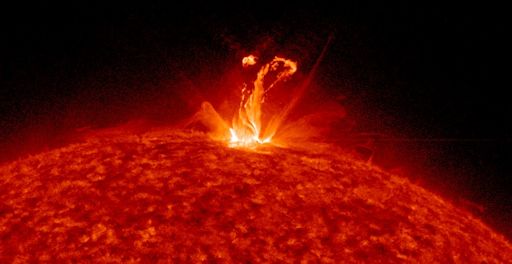
Numbered AR2661, this new sunspot is still rotating into view, so its full size and potential for stronger flares are not yet known. Stay tuned for updates as AR2661 turns toward Earth. Free: Solar Flare Alerts
Realtime Space Weather Photo Gallery
A QUAKE IN EARTH'S MAGNETIC FIELD: A solar coronal mass ejection (CME) struck Earth on May 27th. In Lancashire, England, a magnetometer operated by Stuart Green captured the subsequent quaking of Earth's magnetic field:
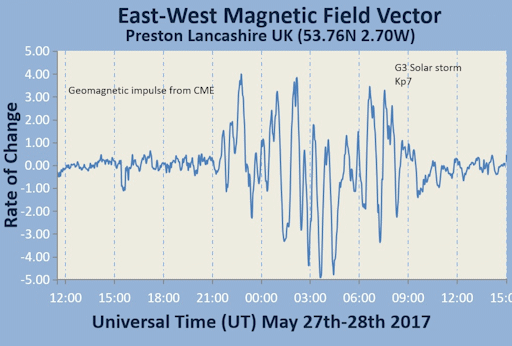
"The CME strike over the weekend left Earth's magnetic field ringing like a bell for around 12 hours, as my magnetometer data show," says Green. "It's always exciting to record such events as it is a tangible reinforcement of the real physical connection between our planet and the powerhouse that sustains life on Earth."
When forecasters say "a geomagnetic storm is in progress," the quaking Green recorded is what they mean. Vibrations in the magnetic field can induce electrical currents in the ground, causing voltage fluctuations in power systems and in rare cases complete blackouts. The same vibrations allow particles normally trapped in our planet's magnetosphere to rain down around the poles, igniting auroras.
The strong geomagnetic storm of May 27-28 registered G3 on the NOAA scale of geomagnetic disturbances. In the northern hemisphere, observers saw Northern Lights as far south as California. In the southern hemisphere, skies lit up like they hadn't for decades:
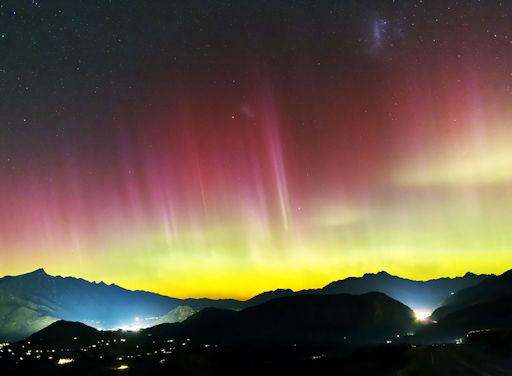
"While I was taking these pictures, I was reminded of displays during the big Solar Maxima of 1989-1990 and 2000-2001, " says photographer Minoru Yoneto of Queenstown, New Zealand. "The Southern Lights could already be seen during astronomical twilight; they were quite strong."
This event is remarkable considering the phase of the sunspot cycle: The sun is rapidly plunging toward Solar Minimum. Sunspots are scarce and solar flares are weak at best. The CME that caused this 'quake' was hurled toward Earth by a seemingly minor magnetic reorganization in the sun's atmosphere. And so space weather continues--no sunspots required. Free: Aurora Alerts
Realtime Aurora Photo Gallery
UNIQUE FATHER'S DAY GIFT: Father's Day is coming soon. What do you give the dad who has everything? How about a trip to the edge of space? For the next two weeks, we're reducing the cost of payload space on Earth to Sky Calculus balloons from $500 to only $299. Buy a "Ticket to Space" before June 15th and give it to dad!
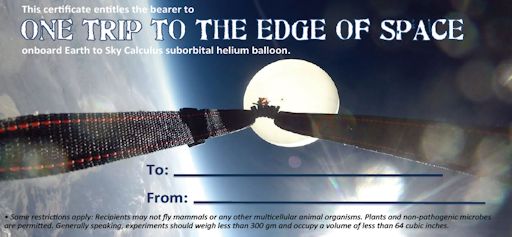
At any time during the next 12 months, he can use this certificate to send an experiment, photo, or keepsake item to the stratosphere, completely supported by an Earth to Sky Calculus launch and recovery team. All items are flown and returned along with video footage, GPS tracking, temperature, pressure, altimetry and radiation data. A Skype brainstorming session is included with each certificate.
More edge of space Father's Day gifts may be found in the Earth to Sky Store.
Far Out Gifts: Earth to Sky Store
All proceeds support hands-on STEM education
NIGHT-GLOWING CLOUDS SIGHTED: Noctilucent cloud (NLC) season is underway. Northern sky watchers are beginning to spot electric-blue tendrils of light creeping over the horizon at sunset. Adrien Mauduit photographed these specimens on May 26th from Ordrup, Sjælland, Denmark:
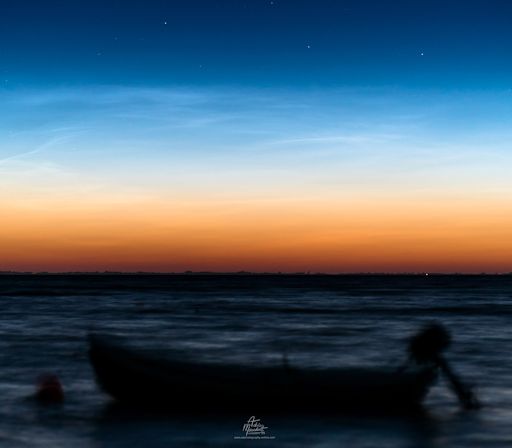
"They were visible until about 2 in the morning," says Mauduit. Follow-up reports of NLCs have been received from Latvia (May 27th) and Northern Ireland (May 31st).
NLCs are Earth's highest clouds. Seeded by meteoroids, they float at the edge of space more than 80 km above the planet's surface. The clouds are very cold and filled with tiny ice crystals. When sunbeams hit those crystals, they glow electric-blue.
Noctilucent clouds are a summertime phenomenon. In the northern hemisphere, they usually appear in late May, then blossom in June and July as ice crystals multiply in the mesosphere high overhead. Here is an example of fully developed NLCs photographed last summer in Sweden:
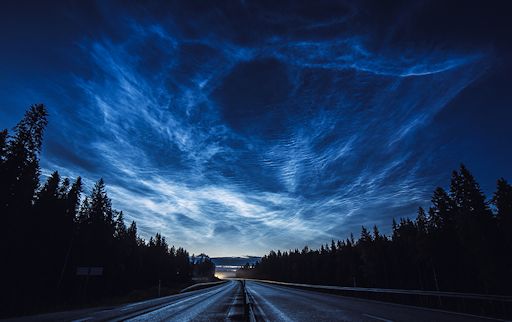
Photo credit: Ruslan Merzlyakov of Umeå, Sweden. August 7, 2016
Interestingly, NLCs haven't always been here. They first appeared in the 19th century after the eruption of super-volcano Krakatoa. At the time, people thought the clouds were caused by the eruption, but long after Krakatoa's ash settled, the clouds remained. In those days, NLCs were a polar phenomenon confined mainly to the Arctic. In recent years they have intensified and spread with sightings as far south as Utah and Colorado. Some researchers believe the intensification is a sign of climate change.
Observing tips: Look west 30 to 60 minutes after sunset when the sun has dipped 6o to 16o below the horizon. If you see luminous blue-white tendrils spreading across the sky, you may have spotted a noctilucent cloud.
Realtime Noctilucent Cloud Photo Gallery
Realtime Comet Photo Gallery
Every night, a network of
NASA all-sky cameras scans the skies above the United States for meteoritic fireballs. Automated software maintained by NASA's Meteoroid Environment Office calculates their orbits, velocity, penetration depth in Earth's atmosphere and many other characteristics. Daily results are presented here on Spaceweather.com.
On Jun. 1, 2017, the network reported 13 fireballs.
(13 sporadics)

In this diagram of the inner solar system, all of the fireball orbits intersect at a single point--Earth. The orbits are color-coded by velocity, from slow (red) to fast (blue). [Larger image] [movies]
Potentially Hazardous Asteroids (
PHAs) are space rocks larger than approximately 100m that can come closer to Earth than 0.05 AU. None of the known PHAs is on a collision course with our planet, although astronomers are finding
new ones all the time.
On June 1, 2017 there were 1803 potentially hazardous asteroids.
 |
Recent & Upcoming Earth-asteroid encounters: | Asteroid | Date(UT) | Miss Distance | Velocity (km/s) | Diameter (m) |
| 2017 CS | 2017-May-29 | 8 LD | 9.1 | 468 |
| 2017 KJ27 | 2017-May-30 | 6.1 LD | 16.2 | 29 |
| 2017 KW31 | 2017-May-31 | 1.2 LD | 10.8 | 17 |
| 418094 | 2017-Jun-01 | 8 LD | 23.2 | 490 |
| 2017 KX4 | 2017-Jun-01 | 15.2 LD | 9.4 | 47 |
| 2017 KJ3 | 2017-Jun-03 | 11.1 LD | 11.3 | 48 |
| 2017 KJ5 | 2017-Jun-04 | 11.6 LD | 3.7 | 16 |
| 2017 KK27 | 2017-Jun-04 | 15.7 LD | 6.5 | 28 |
| 2017 KR27 | 2017-Jun-06 | 7 LD | 12.5 | 68 |
| 2017 KQ27 | 2017-Jun-06 | 1 LD | 10.7 | 24 |
| 2017 HV4 | 2017-Jun-10 | 19.5 LD | 3.9 | 50 |
| 2017 KF3 | 2017-Jun-11 | 12.9 LD | 11.2 | 41 |
| 2010 VB1 | 2017-Jun-16 | 10.3 LD | 8.3 | 81 |
| 471984 | 2017-Jun-18 | 19.1 LD | 7.7 | 102 |
| 441987 | 2017-Jun-24 | 7.9 LD | 12.7 | 178 |
| 2017 BS5 | 2017-Jul-23 | 3.2 LD | 5.8 | 54 |
Notes: LD means "Lunar Distance." 1 LD = 384,401 km, the distance between Earth and the Moon. 1 LD also equals 0.00256 AU. MAG is the visual magnitude of the asteroid on the date of closest approach. | | Cosmic Rays in the Atmosphere |
Readers, thank you for your patience while we continue to develop this new section of Spaceweather.com. We've been working to streamline our data reduction, allowing us to post results from balloon flights much more rapidly, and we have developed a new data product, shown here:

This plot displays radiation measurements not only in the stratosphere, but also at aviation altitudes. Dose rates are expessed as multiples of sea level. For instance, we see that boarding a plane that flies at 25,000 feet exposes passengers to dose rates ~10x higher than sea level. At 40,000 feet, the multiplier is closer to 50x. These measurements are made by our usual cosmic ray payload as it passes through aviation altitudes en route to the stratosphere over California.
What is this all about? Approximately once a week, Spaceweather.com and the students of Earth to Sky Calculus fly space weather balloons to the stratosphere over California. These balloons are equipped with radiation sensors that detect cosmic rays, a surprisingly "down to Earth" form of space weather. Cosmic rays can seed clouds, trigger lightning, and penetrate commercial airplanes. Furthermore, there are studies ( #1, #2, #3, #4) linking cosmic rays with cardiac arrhythmias and sudden cardiac death in the general population. Our latest measurements show that cosmic rays are intensifying, with an increase of more than 13% since 2015:
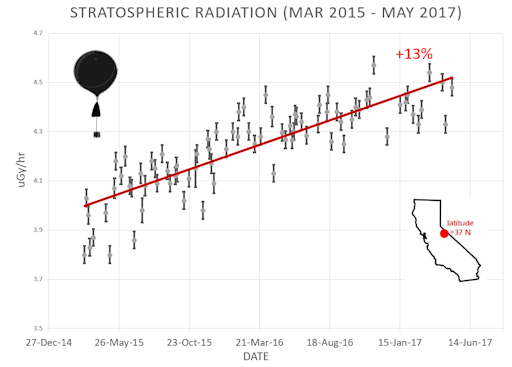
Why are cosmic rays intensifying? The main reason is the sun. Solar storm clouds such as coronal mass ejections (CMEs) sweep aside cosmic rays when they pass by Earth. During Solar Maximum, CMEs are abundant and cosmic rays are held at bay. Now, however, the solar cycle is swinging toward Solar Minimum, allowing cosmic rays to return. Another reason could be the weakening of Earth's magnetic field, which helps protect us from deep-space radiation.
The radiation sensors onboard our helium balloons detect X-rays and gamma-rays in the energy range 10 keV to 20 MeV. These energies span the range of medical X-ray machines and airport security scanners.
The data points in the graph above correspond to the peak of the Reneger-Pfotzer maximum, which lies about 67,000 feet above central California. When cosmic rays crash into Earth's atmosphere, they produce a spray of secondary particles that is most intense at the entrance to the stratosphere. Physicists Eric Reneger and Georg Pfotzer discovered the maximum using balloons in the 1930s and it is what we are measuring today.
| | The official U.S. government space weather bureau |
| | The first place to look for information about sundogs, pillars, rainbows and related phenomena. |
| | Researchers call it a "Hubble for the sun." SDO is the most advanced solar observatory ever. |
| | 3D views of the sun from NASA's Solar and Terrestrial Relations Observatory |
| | Realtime and archival images of the Sun from SOHO. |
| | from the NOAA Space Environment Center |
| | a proud supporter of science education and Spaceweather.com |
| | fun to read, but should be taken with a grain of salt! Forecasts looking ahead more than a few days are often wrong. |
| | from the NOAA Space Environment Center |
| | the underlying science of space weather |
 | Beautyz for top beauty products reviews and their buying guides |
 | Reviews here can help you to pick up best memory foam mattresses. |
| | These links help Spaceweather.com stay online. Thank you to our supporters! |
| | | | | | |

